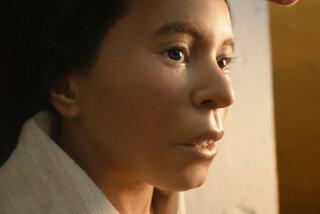Mayan Jade, Flint and Shell Artifacts Discovered
- Share via
WASHINGTON — A well-preserved cache of artifacts, including exquisite jade carvings and a shell that may contain the blood of a Mayan king, has been uncovered in the ancient city of Copan, archeologists said Wednesday.
The 1,200-year-old hoard of jade, flint and shell artifacts was found beneath an altar at the foot of a temple pyramid of the old city in western Honduras, they said.
“This is the finest ceremonial offering that’s yet been discovered in the ruins of Copan,” said William L. Fash of Northern Illinois University, head of the team that made the discovery.
The offerings found under the altar include two large jade pieces carved in the shape of human and supernatural figures, three elaborate flint lance heads with Maya faces chipped in profile, stingray spines and a spiny oyster shell.
King Named ‘Smoke-Shell’
The scientists said one of the main discoveries is a reddish-brown substance inside the oyster shell. If the material is dried blood, as the researchers suspect, it almost certainly would be that of a Mayan king, the pyramid’s final owner.
Hieroglyphic symbols indicate the king’s name was “Smoke-Shell,” the archeologists said.
Stingray spines commonly were used by Mayan men in ritual bloodletting. The scientists think the offerings were made, and Smoke-Shell’s bloodletting performed, at the dedication ceremony of the tall pyramid-temple 1,231 years ago.
Temple-pyramid 26, previously known for its large hieroglyphic stairway, was dedicated in AD 756, during the Classic Period of the Copan Maya.
Student Made Discovery
The other jewels of the discovery, made by Princeton University student David Stuart, were the jade pieces. These included a 7-inch-tall, full-round statuette of a squat male figure clad only in a loincloth and headband.
The other major jade, a flat plaque about 10 inches long that was worn on the chest, is the largest jade ever found at Copan. It represents a Maya god associated with symbols of the sun and the jaguar on one side and has the image of the supernatural serpent deity on the other.
“The really neat thing about both jades is that they are heirlooms--pieces that had been owned by previous kings in Copan and passed down from generation to generation,” Fash said.
More to Read
Sign up for Essential California
The most important California stories and recommendations in your inbox every morning.
You may occasionally receive promotional content from the Los Angeles Times.













